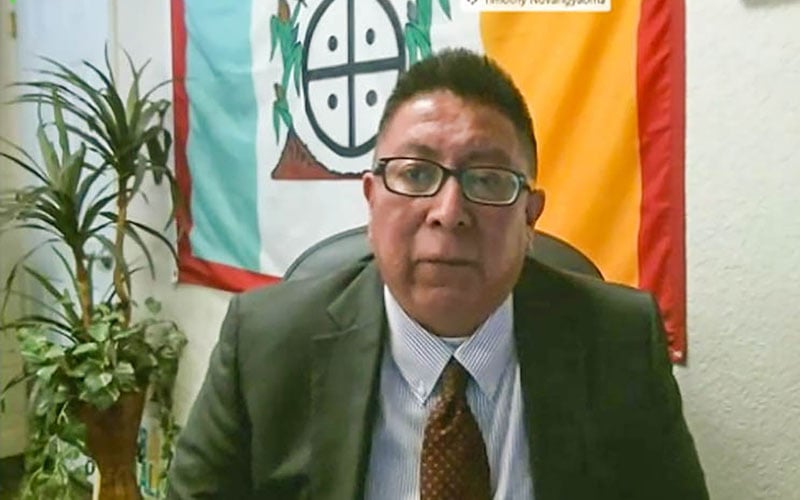
Hopi Chairman Timothy Nuvangyaoma told the Senate Indian Affairs Committee that renewal of a special diabetes prevention program is “critical” for tribes. But the program will expire in months if Congress does not act. (Photo courtesy Senate Indian Affairs Committee)
WASHINGTON – A “life-changing” diabetes program for Native Americans will expire Dec. 11 if Congress doesn’t take action, advocates said.
Hopi Chairman Timothy Nuvangyaoma said it is “critical” that lawmakers reauthorize the Special Diabetes Program for Indians, which serves tribes across Arizona and the nation.
“There is no doubt that our program has changed the course of diabetes in the Hopi community,” said Nuvangyaoma, in virtual testimony last week to the Senate Indian Affairs Committee. He said the program, which incorporates Hopi culture, served more than 17,000 people last year alone.
The Hopi diabetes program is one of 27 similar community-directed efforts in Arizona funded by the Special Diabetes Program for Indians, which operates in tribal communities in 35 states. The national program was credited in one study with a significant decline in Native American diabetes rates since 2013. The $150 million program was also found to have saved Medicare $52 million annually.
Everyone agrees that the program should be extended, but Congress cannot seem to agree on the long-term funding – and stability – supporters say the program needs.
“While demonstrably effective, the diabetes program has suffered in recent years from a series of short-term reauthorizations and stagnant funding that’s hindered the program’s full potential,” said Sen. Martha McSally, R-Arizona, during the hearing. Uncertain funding chokes prevention efforts – a major detriment when “long-term strategies are key to successfully getting type-two diabetes rates in check.”
The program was created in 1997 and has been extended for as long as five years at a time, but recently Congress has moved toward short-term extensions. The most recent extensions have lasted months and the latest, which would include the program in a stopgap budget resolution, would extend it just 11 days, from Nov. 30 to Dec. 11.
McSally introduced a bill, co-sponsored by Sen. Kyrsten Sinema, D-Arizona, to increase funding and extend for five years the decades-long program that has been wildly successful in improving diabetes rates in Native American communities across the country. Rep. Tom O’Halleran, D-Sedona, has introduced a similar bill in the House.
When it was up for renewal last year, it passed with more than 80% of the House vote and over 70% of the Senate, astonishing levels of support in the current partisan climate, said Stacy Bohlen, executive director of the National Indian Health Board.
If the program is not extended, “dire isn’t even the appropriate word for how serious it would be,” Bohlen said.
“Nobody’s getting those kind of numbers,” Bohlen said of the program’s positive results. “Tribes are knocking this out of the park and, instead of being rewarded for that, they’re being knocked down.”
The Hopi first received federal diabetes program funding in 1998. Their program focuses on reducing obesity, improving nutrition, addressing food insecurity and promoting physical fitness – all diabetes-prevention measures.
Tribes and health advocates have been seeking long-term reauthorization for years, in addition to an increase in funding. The annual $150 million budget has a third less buying power than it did in 2004, the last time Congress increased its funding.
There’s “an appetite” on Capitol Hill to renew the program for five years, said Meredith Raimondi, director of congressional affairs for the National Council of Urban Indian Health. But the COVID-19 pandemic, combined with an election year, has delayed what was already a slow process.
“Everything that was moving forward … got pushed to the back burner,” Raimondi said.
COVID-19 has hit tribal communities hard, in part because of high rates of preexisting conditions like diabetes – one of the top risk factors for more serious and even deadly COVID-19 infections. Diabetes is the fourth-leading cause of death for Native Americans, McSally said in her remarks to the committee, compared to seventh in the general population.
“The COVID-19 pandemic has underscored the critical need to address underlying health conditions such as diabetes,” said McSally, and her bill “will provide long-term stability” to tribes’ diabetes programs.
Bohlen said that stability is critical: The last year of funding uncertainty has already started to disrupt the program and “the level of disruption and despair that’s ensued is astronomical.” It is “notoriously difficult” at the best of times to recruit and retain medical professionals in Indian Country, where Bohlen said the Indian Health Service has a 25% staff vacancy.
“If you have rumblings every … 11 days that your funding was probably going to run out for your job, would you not be looking for another job?” she said.
Even before the pandemic hit, uncertain funding kept IHS from awarding new grants to tribes. This kept new tribes from entering the program and kept existing programs on “autopilot,” Bohlen said.
Advocates are hoping the reauthorization can be attached to another appropriations bill or, more likely, rolled into a new coronavirus relief bill. The diabetes program won its longest extension this year as part of the original Coronavirus Aid, Relief, and Economic Security, or CARES, Act.
Raimondi said tribes and health advocates will keep pushing Congress with “great urgency” to reauthorize the program.
“We can’t afford to not have it,” she said.



